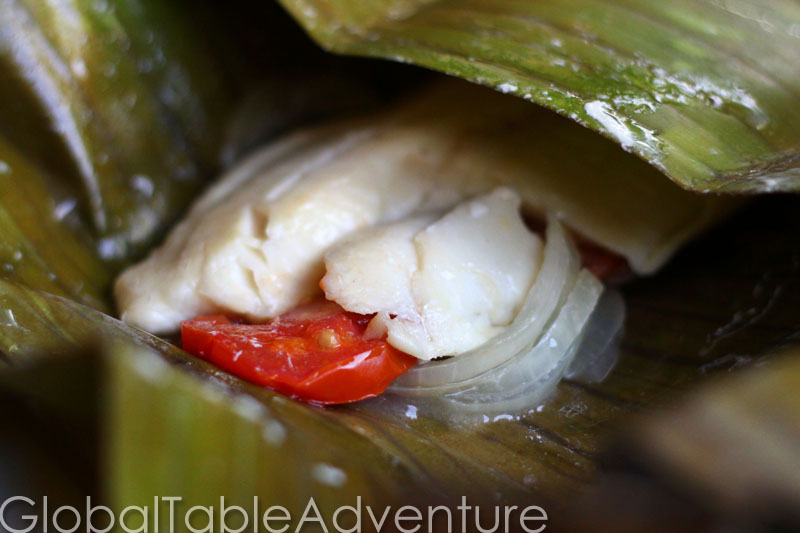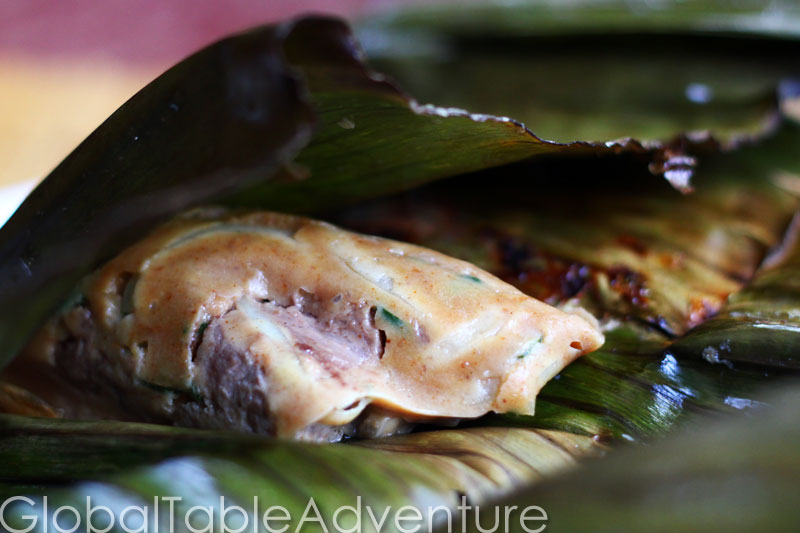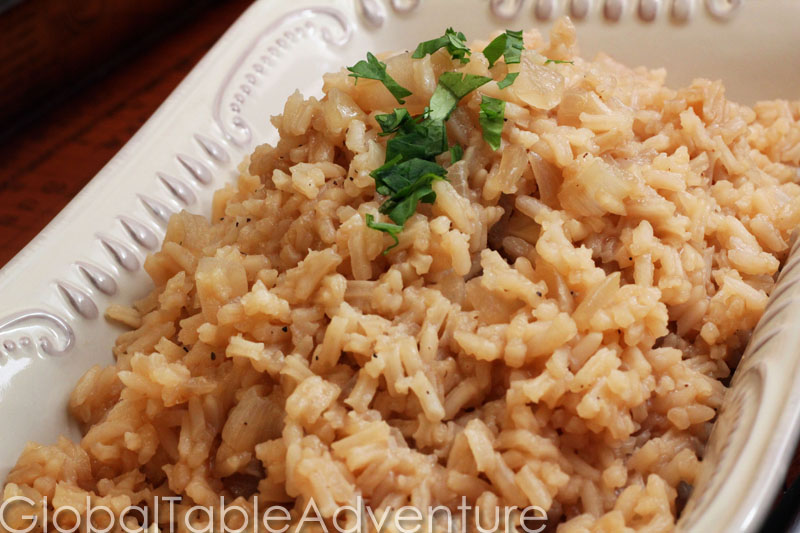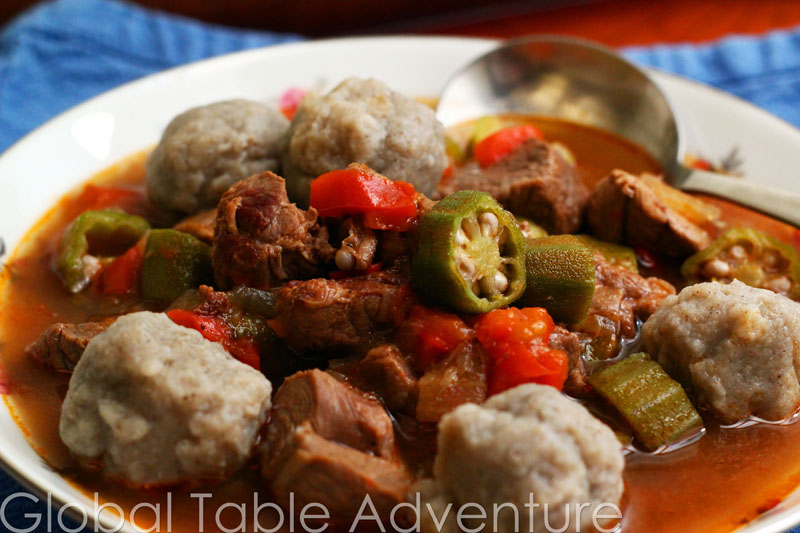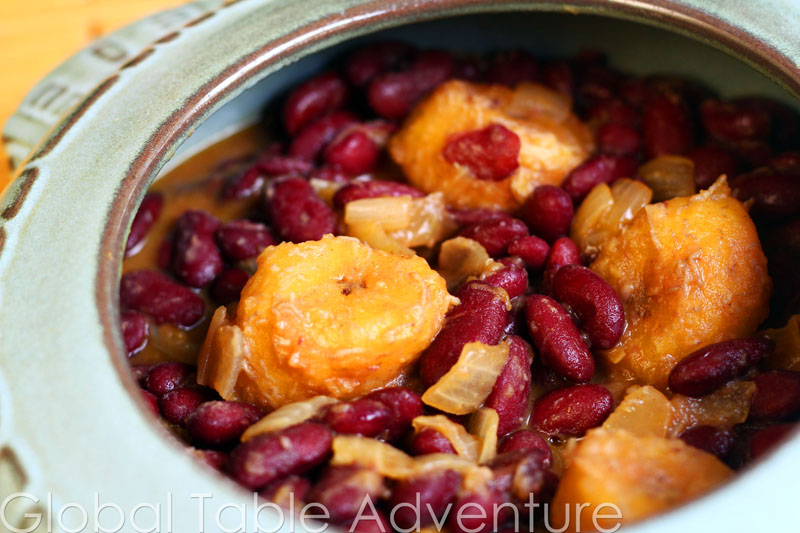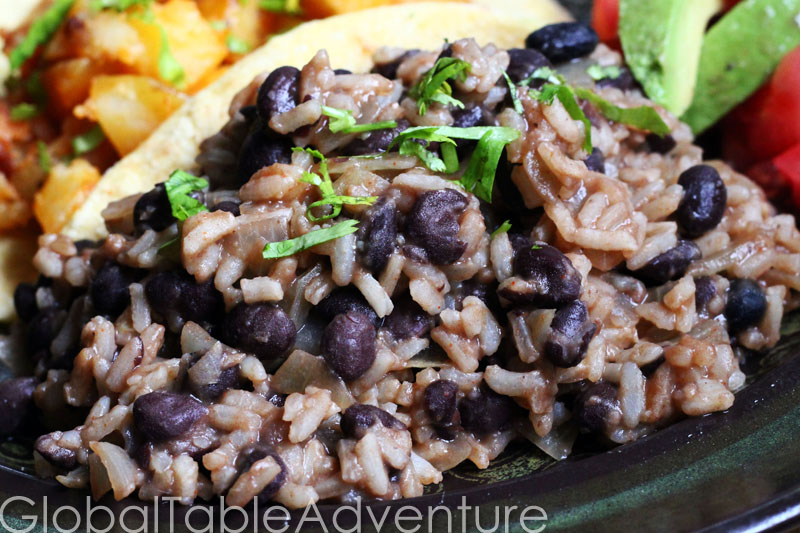
Gallo Pinto is enjoyed by Costa Ricans year-round, for breakfast, lunch, or dinner. The beans and rice are mildly seasoned, however the Worcestershire sauce gives the dish an unusual kick. Ingredients: 2 1/2 cups leftover, cooked white rice 2 cans black beans, drained and rinsed 1 onion, chopped 4 cloves of garlic, crushed oil 1/2 tsp paprika 1/8 cup Worcestershire sauce 1 cup broth or water salt and pepper Method: Heat oil over medium heat. Add onion. After just a moment, the entire house will smell like “good.” Now we’re cookin’! Add the garlic… … and cook until onion is soft and turning slightly golden – or however you like to eat it. I prefer not to have any crunch in mine. Then, add in the paprika. And leftover rice. I love re-purposing food… making my dollar stretch over several meals. Pile on the beans. I used canned beans for simplicity and speed. Next, a little Costa Rican flavor – sprinkle in the Worcestershire sauce. (And don’t forget the salt and pepper) Add in water to help mix everything …
Read More
Serves 4 Steaming fish in banana leaves – extremely common in Africa – results in a light, healthy dish. Liboke is a congolese word (in the Lingala dialect) for packets of food cooked in banana leaves. Ingredients: 4 fish fillets (I used tilapia, you can use any white fish you like) 4 banana leaves (or sheets of aluminum foil) 1/2 onion, thinly sliced 1-2 tomatoes, thinly sliced lemon juice, to taste salt cayenne pepper Method: First, prepare the banana leaves. Trim off the tough side of the leaf. Then run the leaf quickly over a flame to soften it and make it more pliable. When it changes from dull to shiny, it is soft enough. Next, assemble the liboke. First the onions. Then, a few tomato slices. Jewl red and just as juicy. A pristine fillet of fish. No square, pressed fish here! Sprinkle with a bit of cayenne, if you dare! Or just a bit of lemon juice. Once you have everything in there, fold up the leaf like a burrito. Top down. Then, …
Read More
Serves 4 This traditional African dish combines peanut butter with goat, two of the most common ingredients in many parts of the continent, especially west and central Africa. Hot peppers and cayenne add kick. Ingredients: 1 lb goat meat, cubed 1/2 onion, sliced thinly 1 poblano pepper, sliced thinly 4 12″x12″ banana leaves (or sheets of aluminum foil) For the Sauce: 3/4 cup peanut butter 1 Tbsp bouillon 1/2 tsp cayenne water, as needed (I used 5 Tbsp) Method: Cube up some goat meat. The butcher cut me two pieces from the leg, with little bone. Next, mix up the ingredients for the sauce. First up – peanut butter. I open the jar, and my husband comes running. He loves the stuff. Some bouillon powder. Cayenne, for heat. Feel free to omit this or use less… but I hope you don’t. Finally, add water and mix all the ingredients together until a smooth sauce forms. I used about 5 tablespoons. Next, add in the meat. And onions. Make sure you slice them as thinly as …
Read More
Serves 2-4 Ahhh… nothing like a nice glass of cola. But what about in rice? The slightly sweet taste will leave you begging for more, especially when served with spicy food (as is common in Colombia). Ingredients: olive oil 1 small onion, chopped 1 cup rice 1 cup broth or water 1 cup cola salt pepper Method: Add a little oil to a small pot. Olive oil makes the world go round. Heat over medium and add chopped onion. Stir and cook for about five minutes. Once they are soft and starting to turn golden, add rice. Stir and cook another few minutes, until rice is hot. Add stock… (or water)… And some cola. Beware the fizzies. Mmm. Drink the leftovers. Or use it to make a Brazilian Mocha Cola! Add salt and pepper. Um. I totally added way too much pepper. This rice had bite! Bring to a boil. Cover and reduce to a simmer. Cook for about 16 minutes. Turn off heat and eat – OR, if you want the best rice ever, follow …
Read More
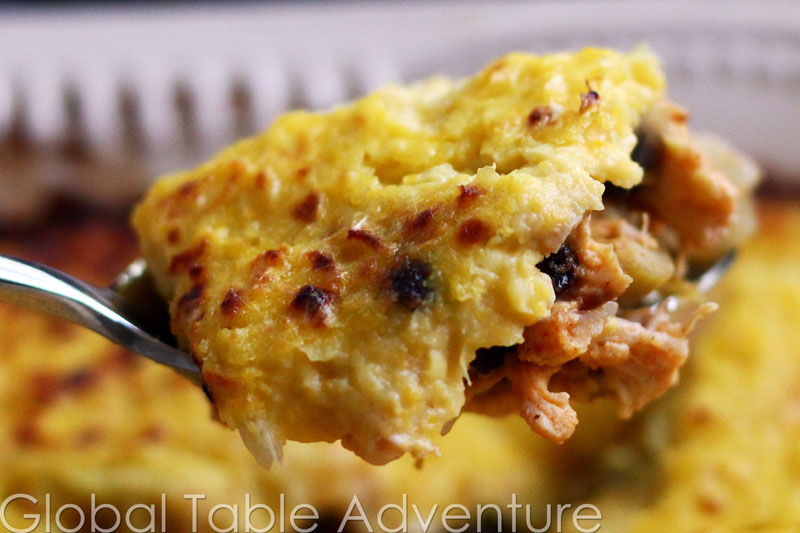
Serves 2-4 Sweet, savory, briney, …. the flavors in Pastel de Choclo are varied and incredible. Special thanks to Linda Bladholm for sharing this authentic Chilean recipe with me. I adapted the version that can be found in Linda’s book, Latin & Caribbean Grocery Stores Demystified. Ingredients: 2 lb rotisserie chicken, taken off the bone 2 onions, chopped 1 tsp paprika 1/4 tsp cumin pinch of cinnamon 5 olives with pimentos, quartered 1/4 cup raisins 2 hardboiled eggs, chopped 3 cups corn kernels 1/2 cup milk a few pinches of sugar for topping Method: Preheat the oven to 350F. Assemble your spices… … and shred up the chicken. Then, saute the chopped onion over medium heat until translucent and soft. Add chicken, raisins (I only had currants), and green olives. Green olives have a special, briney place in my heart. Then add chopped egg and spices. Stir to combine and warm everything through. Spread into a medium casserole. Easy! Next step is easy too… In a blender, puree corn with a little milk Mmm. Spread the corn …
Read More
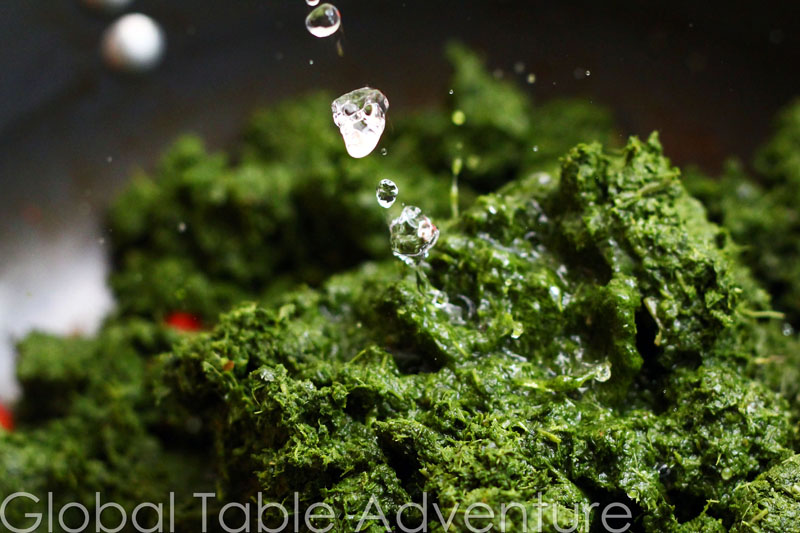
Serves 4-6 Cassava leaves are highly fibrous, dense and grassy. We found ours frozen and “ground” at Ebutte Tropical Market – which saved us a lot of sweat around a mortar and pestle. You could easily double the aromatics in this recipe as the flavors rather get lost behind the domineering cassava. Ingredients: red palm oil 1 large onion, chopped 2 tomatoes, chopped 1 1/2 lbs fresh ground cassava leaves 1 Tbsp peanut butter water salt pepper Method: Thaw out some fresh ground cassava leaves. Over medium heat, cook chopped onion in a drizzle of red palm oil. Note how the oil stains the onions gold. Add tomatoes. And the cassava leaves. The smell will transport you to hay-ville. If such a place exists. Add enough water to keep things moist and sludgey, so that the mixture doesn’t burn. Bring to a simmer. Stir in peanut butter. Stew over low heat, covered, for about 30 minutes. Serve immediately with an Adventurous spirit. Stewed Cassava Leaves Votes: 0 Rating: 0 You: Rate this recipe! Print Recipe …
Read More
Makes about 2 cups Raw seeds give Egusi sauce grassy flavor and a little bit of texture. The sauce is popular in central Africa, and can be served over vegetables, meats, and fish. Ingredients: 1 small onion 1 tomato 1 chili pepper (I used a poblano from my garden, but you can go as spicy as you want with this recipe) salt red chili powder, to taste 1 1/2 cups ground egusi 1/2 cup water (or as needed) Method: Hunt down some ground melon seeds. I found these at our local African market. Latino stores have pepitas, or pumpkin seeds, which are an acceptable substitute. In a food processor, add tomato… Coarsely chopped onion … And a chili pepper. I left the poblano on the plant long enough that it turned red. The extra time on the plant made it sweeter 🙂 Puree everything together… Add it to a small pot with the egusi… Some salt and pepper… And water… Things don’t look so tasty here… but as the water mixes in, things smooth out. …
Read More
Serves 2-3 Amazingly enough, Keith had never had lamb before we embarked on our Adventure to eat food from around the world. This stew is so fresh and flavorful it won him over immediately. Serve with millet balls. The key to making good lamb stew is to simmer -never boil – the meat. For the first hour the meat will seem tough and chewy but, incredibly, in the second hour even the toughest cut softens, tenderizes and gets that “melt in your mouth” quality that makes stew completely irresistible. Ingredients: vegetable oil 1 1/2 lb lamb, cubed 1 large onion, chopped 1 bell pepper, cut into strips 1 tsp paprika 1 Tbsp tomato paste 4 cups water, or as needed 1/2 lb chopped okra Method: Heat a little oil in a medium pot. Brown lamb – do not crowd. Brown in small batches if needed. When done, return all the meat to the pot and crank the heat to get things moving. Add onion, bell pepper, paprika and tomato paste. I emptied out my paprika jar …
Read More

Makes about 1.5 gallons Cachupa is the quintessential Cape Verdean dish. While there are countless variations, almost all Cachupas have hominy, beans, and potatoes. Some add yucca. Any assortment of vegetables and legumes can be added, depending on availability. For those who can afford it, dried and smoked Portuguese sausages are also added for tremendous “stick to your bones” flavor. Fish, such as tuna and wahoo, is a little more attainable for the average citizen. Our version is vegan and more affordable. More in the mood for breakfast? Leftover Cachupa will suit you too. In fact, refried cachupa (cachupa rafogado) is often served with fried eggs. Nothing like sight, smell, and sound of sizzling eggs in the morning… Tradition vs. our version: Traditionally and typically, the hominy is pounded prior to cooking, however our version leaves the kernel whole for texture. Even still, the entire stew infuses with the soft corn-like flavor of this addictive grain. If you’ve never tried hominy, run out now and buy some! Add it to any stew for wonderful, slightly chewy …
Read More
Serves 4 If you can make this African bean dish a day ahead, please do. The sauce will thicken and coat every millimeter of the beans with chili and onion goodness. Great side dish for a party! Ingredients: 3 cups prepared red kidney beans (2 cans) 2 Tbsp red palm oil 1 onion, sliced 1 plantain, sliced salt 1 tsp chili powder 2 cups water Method: 1. Heat oil over medium heat, cook onion 2. Add beans, plantains, salt, and chili pepper. Cook for a minute. 3. Add water and simmer until plantains are cooked and about a 1/2 cup of liquid is left in the pan – 30 -45 min I chose a plantain with blackened skin. Unlike a banana, where darker skin indicates over-ripeness, blackened skin in a plantain indicates perfect sweetness with a little tooth – perfect for a short simmer. Always rinse canned beans. I bought “no salt added” to keep this dish low sodium. This photo flashes me back to spoonfuls of cod liver oil as a child. Luckily, red palm oil …
Read More
Serves 2-3 Make this African dish with your favorite white fish. In Burundi, they use whole Ndagala or mukéké. The tomatoes and onion make a fresh, brothy sauce, while a pinch of fresh parsley enhances the flavor. Sometimes the fish is fried separately, then added to the sauce. I prefer the health benefits of gently steaming the fish over the sauce. Ingredients: 1 Tbsp red palm oil 1 lb fish (we used cod) 1 onion, chopped 3 tomatoes, chopped 1 habenero (whole or halved) 1 cup water Salt to taste Method: 1. Heat oil over medium heat. Add onion and cook until soft. Then add tomatoes, habenero, water, and salt. 2. Simmer, uncovered, about 15-30 minutes, until the tomatoes break down into a light, brothy sauce. If you prefer a more reduced sauce – or less, adjust time to your preferences. 3. Add fish, cover, and cook until done. This will depend on the thickness of your fish. Check to make sure the fish flakes easily to determine if done. Ours took about 15 minutes. Tomatoes …
Read More
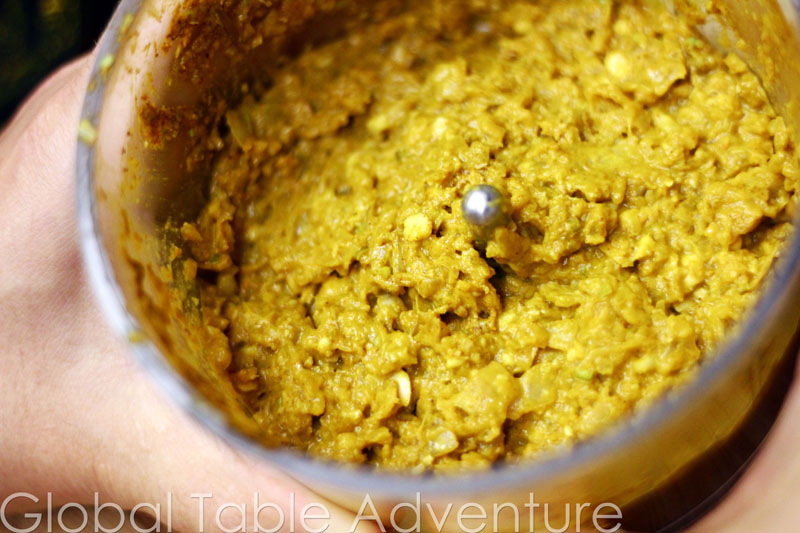
Makes enough for about 2 curries (more if you like them mild) Rempah, a common curry blend in Brunei, will infuse your meal with the most haunting flavors of garlic, ginger, lemongrass… spicy chili pwder and golden turmeric. The entire kitchen smells like paradise when you cook with Rempah. PS. You can use this in our recipe for Sayur Lodeh. Ingredients: 1/8 cup cashews 1 onion, chopped 3 cloves garlic 1 tsp chili powder 1 tsp ground turmeric 1 tsp ground coriander 1 Tbsp belachan or anchovy paste 1 Tbsp chopped, fresh lemongrass 1″ fresh ginger, chopped 1 Tbsp vegetable oil Method: 1. Add all ingredients to a small food processor. The fresh lemongrass is actually from my garden! It looks like a giant piece of overgrown grass, but with the most incredible, lemony-spring scent. Clip the lemongrass as close to the ground as you can. Here’s what not to do: The bottom ends have all sorts of tasty goodness that gets infused into the curry, when it cooks. Don’t forget the bechalon/anchovy paste. It …
Read More


